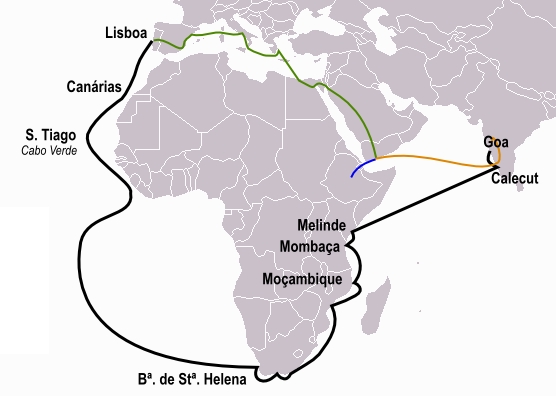The Spy who Never came back
Pêro da Covilhã
by Frederic (Jim) Silva
In the true tales of high adventure the story of Marco Polo’s travels have been indelibly recorded in history. But few have ever heard of one Pêro da Covilhã.
And yet Pêro da Covilhã’s travels and exploits can come a close second to those of Polo. Perhaps one of the reasons for Covilhã’s relative obscurity was that he left no written record of his explorations and apart from his letter reporting to his King it was left to others to write of him.
Marco Polo’s journey was in the years around 1270, at the time when Kublai Khan was on the throne as Emperor of China. Covilhã’s travels took place some 200 years later, around 1480.
The Age of Discovery was in full swing when King John II of Portugal entrusted two men, Pêro da Covilhã and Afonso da Paiva, to go east to explore and discover on his behalf. Yes, you can even say – to spy. Unlike other ongoing discoveries this was not to be the usual expensive sea-borne expedition, but rather a surreptitious and unobtrusive overland trip. One reason why Covilhã was chosen was because of his knowledge of Arabic which was then still commonly used in parts of lberia.
The King’s instruction to the men was twofold. First, Christendom was desperate to prevail over Islam and the explorers were told to make contact with a legendary King called Prester John and to seek a Christian alliance with him against Islam. Second, it would be useful to know the exact geographical location where many of the prized spices came from.
Where did cinnamon originate? Cloves? Mace? Nutmeg? and Pepper? From where exactly did the Venetians and their Middle Eastern trading partners get their goods?

The two men set off. They travelled through Barcelona, Naples and Rhodes. They made their way to Egypt, Alexandria and Cairo, and there they joined an Arab caravan to Aden. They went right to the extreme tip of the Saudi Arabian peninsula. It must have been high adventure as new and unknown worlds opened.
At Aden the two men parted company. Paiva proceeded to Ethiopia where he was never heard from again. It was thought that he soon died there. Covilhã went on to India and landed at Calicut. It was in a subsequent letter to his King that he pointed to Calicut as a leading trading post on India’s west coast and it was this information that later guided Vasco da Gama to and there.
Covilhã made his way back to Cairo via Goa and Ormuz and there he made contact with emissaries of his King. He reported by letter on his travels thus far and in turn was instructed to carry on in his search for Prester John.
Covilhã straddled the Red Sea. He reached Jeddah, Mecca and Medina before finally reaching Ethiopia, which legend indicated was the home of Prester John.
Instead of a hoped for powerful Christian King and ally, what he found instead was yet another poor backward African nation practicing variant forms of Christian belief. Nevertheless Covilhã was well received and royally treated with land and honours. The only problem was that he was not ever allowed to leave.
The years passed and in 1520 a Portuguese mission to Ethiopia came across Covilhã, still there after a stay of thirty years. What a re-union it must have been. To hear the voices and language of his countrymen after all this time. To hear of people and events that had taken place. To learn that a sea-borne landing had been made in Calicut. Perhaps finding out that his countrymen had gone even further east to Malacca and China; and that a new King was now on the throne. It must have been like awakening from a Rip Van Winkle sleep of years.
Covilhã in turn supplied his countrymen with information and news on his part of the world. He taught them words from the language and the customs of the people. They dubbed him “An honourable person of merit and credit”.
The emissaries now offered to take Covilhã home with them but he refused the invitation. He knew that he would now be a stranger in his land of birth and would not fit in anymore. Moreover, he had a second wife and family in Ethiopia and complications would arise over his first wife and family in Portugal.
Covilhã died a pioneer and respected Patriarch in his home in Africa. He was buried accompanied by the basic Christian rites – with somewhat different ceremonies from what would otherwise have been had they taken place in Portugal.
O Espião que Nunca Voltou
Pêro da Covilhã
Frederic (Jim) Silva
Nos contos verdadeiros de alta aventura, a história das viagens de Marco Polo foi indelevelmente registrada na história. Mas poucos já ouviram falar de um Pêro da Covilhã.
E, no entanto, as viagens e façanhas de Pêro da Covilhã podem chegar em segundo lugar às do Polo. Talvez uma das razões para a relativa obscuridade de Covilhã foi que ele não deixou nenhum registro escrito de suas explorações e, além de sua carta relatando ao seu rei, foi deixado para outros escrever sobre ele.
A jornada de Marco Polo foi nos anos por volta de 1270, na época em que Kublai Khan estava no trono como Imperador da China. As viagens da Covilhã aconteceram cerca de 200 anos depois, por volta de 1480.
A Era dos Descobrimentos estava em pleno andamento quando o rei D. João II de Portugal confiou a dois homens, Pêro da Covilhã e Afonso da Paiva, para ir para leste para explorar e descobrir em seu nome. Você pode até dizer – espionar. Ao contrário de outras descobertas em curso, esta não era para ser a expedição habitual cara transportada pelo mar, mas sim uma viagem terrestre sub-reptícia e discreta. Uma razão pela qual a Covilhã foi escolhida foi por causa de seu conhecimento do árabe, que ainda era comumente usado em partes da UBRIA.
A instrução do rei aos homens era dupla. Primeiro, a cristandade estava desesperada para prevalecer sobre o Islã e os exploradores foram instruídos a fazer contato com um rei lendário chamado Prester John e buscar uma aliança cristã com ele contra o Islã. Em segundo lugar, seria útil saber a localização geográfica exata de onde vinham muitas das especiarias valorizadas.
Onde se originou a canela? Cravos? Mace? Noz-moscada? E o Pepper? De onde exatamente os venezianos e seus parceiros comerciais do Oriente Médio conseguiram seus produtos?

Os dois homens partem. Eles viajaram por Barcelona, Nápoles e Rodes. Eles fizeram o seu caminho para o Egito, Alexandria e Cairo, e lá eles se juntaram a uma caravana árabe para Áden. Eles foram direto para a ponta extrema da península da Arábia Saudita. Deve ter sido uma grande aventura à medida que mundos novos e desconhecidos se abriram.
Na Aden, os dois homens se separaram. Paiva seguiu para a Etiópia, onde nunca mais foi ouvido. Pensava-se que ele logo morreu lá. A Covilhã foi para a índia e desembarcou em Calecute. Foi em uma carta subsequente ao seu rei que ele apontou para Calcut como um importante posto comercial na costa oeste da índia e foi essa informação que mais tarde guiou Vasco da Gama para e para lá.
Covilhã fez o seu caminho de volta para o Cairo através de Goa e Ormuz e lá ele fez contato com emissários de seu rei. Ele relatou por carta em suas viagens até agora e, por sua vez, foi instruído a continuar em sua busca por Prester John.
A Covilhã atravessou o Mar Vermelho. Ele chegou a Jeddah, Meca e Medina antes de finalmente chegar à Etiópia, que a lenda indicou ser a casa de Prester John.
Em vez de um esperado para o poderoso rei cristão e aliado, o que ele Encontrou em vez disso foi outra pobre nação africana atrasada praticando formas variantes de crença cristã. No entanto, a Covilhã foi bem recebida e tratada com terras e honrarias. O único problema era que ele nunca tinha permissão para sair.
Os anos passaram e em 1520 uma missão portuguesa à Etiópia se deparou com a Covilhã, ainda lá depois de uma estadia de trinta anos. O que é uma re-união deve ter sido. Ouvir as vozes e a linguagem de seus compatriotas depois de todo esse tempo. Ouvir falar de pessoas e eventos que aconteceram. Para saber que um pouso marítimo tinha sido feito em Calicut. Talvez descobrindo que seus compatriotas tivessem ido ainda mais para o leste para Malaca e China; e que um novo rei estava agora no trono. Deve ter sido como acordar de um sono de Rip Van Winkle de anos.
A Covilhã, por sua vez, forneceu aos seus compatriotas informações e novidades de sua parte do mundo. Ele ensinou-lhes palavras da língua e dos costumes do povo. Eles o apelidaram de “uma pessoa honrada de mérito e crédito”.
Os emissários agora se ofereceram para levar a Covilhã para casa, mas ele recusou o convite. Ele sabia que agora seria um estranho em sua terra natal e não se encaixaria mais. Além disso, ele tinha uma segunda esposa e família na Etiópia e complicações surgiriam sobre sua primeira esposa e família em Portugal.
A Covilhã morreu como pioneiro e respeitado Patriarca em sua casa na África. Ele foi enterrado acompanhado pelos ritos cristãos básicos – com cerimônias um pouco diferentes do que teria sido se tivessem ocorrido em Portugal.
